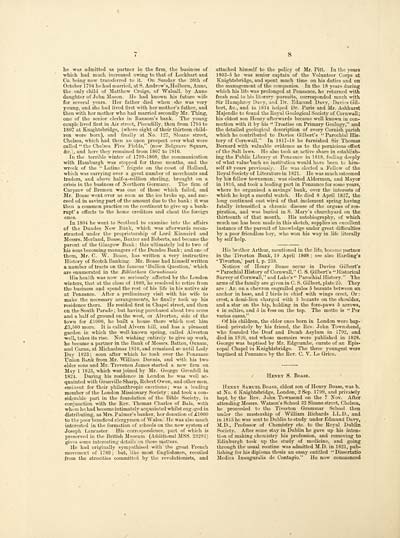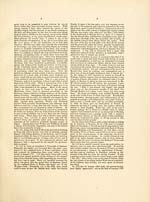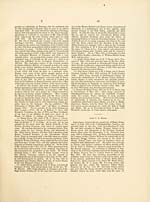Download files
Complete book:
Individual page:
Thumbnail gallery: Grid view | List view

8
he was admitted as partner in the firm, the business of
which had much increased owing to that of Lockhart and
Co. being now transferred to it. On Sunday the 26th of
October 1794 he had married, at S. Andrew's, Holborn, Anne,
the only child of Matthew Craige, of Walsall, by Anne
daughter of John Mason. He had known his future wife
for several years. Her father died when she was very
young, and she had lived first with her mother's father, and
then with her mother who had married secondly Mr. Thing,
one of the senior clerks in Ransom's bank. The young
couple lived first in Air street, Piccadilly, then from 1795 to
1807 at Kmghtsbridge, (where eight of their thirteen child-
ren were born), and finally at No. 127, Sloane street,
Chelsea, which had then an open prospect over what were
called " the Chelsea Five Fields," (now Belg-rave Square,
&c), and here they remained from 1807 to 1810.
In the terrible winter of 1799-1800, the communication
with Hamburgh was stopped for three months, and the
wreck of the " Lutine " frigate on the coast of Holland,
which was carrying over a great number of merchants and
traders, and above half-a-million sterling, brought on a
crisis in the business of Northern Germany. The firm of
Carpzov of Bremen was one of those which failed, and
Mr. Boase went over as soon as the ice broke up, and suc-
ceed ed in saving part of the amount due to the bank : it was
then a common practice on the continent to give up a bank-
rupt' s effects to the home creditors and cheat the foreign
ones.
In 1804 be went to Scotland to examine into the affairs
of the Dundee New Bank, which was afterwards recon-
structed under the proprietorship of Lord Kinnaird and
Messrs. Morland, Boase, Baxter and B.oberts, and became the
parent of the Glasgow Bank: this ultimately led to two of
his sons becoming managers of the Dundee Bank ; and one of
them, Mr. 0. W. Boase, has written a very instructive
History of Scotch Banking. Mr. Boase had himself written
a number of tracts on the famous ' Bullion Question,' which
are enumerated in the Bibliotheca Cornttbiensis
His health was now so seriously affected by the London
winters, that at the close of 1809, he resolved to retire from
the business and spend the rest of his life in his native air
at Penzance. After a preliminary visit with his wife to
make the necessary arrangements, he finally took up his
residence there. He resided first in Chapel street, and then
on the South Parade ; but having purchased about two acres
and a half of ground on the west, or Alverton, side of the
town for £1000, he built a house there which cost him
£3,500 more. It is called Alvern hill, and has a pleasant
garden in which the well-known spring, called Alverton
well, takes its rise. Not wishing entirely to give up work,
he became a partner in the Bank of Messrs. Batten, Oxnam,
and Carne, at Michaelmas lS10,and remained so until Lady
Day 1823 ; soon after which he took over the Penzance
Union Bank from Mr. William Dennis, and with his two
elder sons and Mr. Trevenen James started a new firm on
May 1 1823, which was joined by Mr. George Grenfell in
1824. During his residence in London he was well ac-
quainted with Granville Sharp, Robert Owen, and other men,
eminent for their philanthropic exertions ; was a leading
member of the London Missionary Society ; and took a con-
siderable part in the foundation of the Bible Society, in
conjunction with the Rev. Thomas Charles of Bala, with
whi >in he had become intimately acquainted whilst eng iged in
distributing, as Mrs. Palmer's banker, her donation of £1000
to the poor beneficed clergymen of Wales. He was also much
interested in the formation of schools on the new system of
Joseph Lancaster. His correspondence, part of which is
preserved in the British Museum (Additional MSS. 29281)
gives some interesting details on these matters.
He had originally sympathised with the great French
movement of 1789 ; but, like most Englishmen, recoiled
from the atrocities committed by the revolutionists, and
attached himself to the policy of Mr. Pitt. In the years
1803-5 he was senior captain of the Volunteer Corps at
Knightsbridge, and spent much time on his duties and on
the management of the companies. In the 18 years during
which his life was prolonged at Penzance, he returned with
fresh zeal to his literary pursuits, corresponded much with
Sir Humphrey Davy, and Dr. Edmund Davy, Davids Gil-
bert, &c, and in 1814 helped Dr. Paris and Mr. Ashhurst
Majendie to found the Royal Geological Society of Cornwall;
his eldest son Henry afterwards became well known in con-
nection with it by his " Treatise on Primary Geology," and
the detailed geological description of every Cornish parish
which he contributed to Davies Gilbert's " Parochial His-
tory of Cornwall." In 1817-18 he furnished Sir Thomas
Bernard with valuable evidence as to the pernicious effect
of the Salt laws. He also took an active share in establish-
ing the Public Library at Penzance in 1818, feeling deeply
of what value 'such an institution would have been to him-
self 40 years previously. He was elected a Fellow of the
Royal Society of Literature in 1821. He was much esteemed
by his fellow townsmen; was elected Alderman, and Mayor
in 1816, and took a leading part in Penzance for some years,
where he organised a savings' bank, over the interests of
which he kept a careful watch. He died 8 April 1827, the
long continued east wird of that inclement spring having
fatally intensified a chronic disease of the organs of res-
piration, and was buried in S. Mary's churchyard on the
thirteenth of that month. His autobiography, of which
much use has been made in this sketch, supplies an excellent
instance of the pursuit of knowledge under great difficulties
by a poor friendless boy, who won his way in life literally
by self help.
His brother Arthur, mentioned in the life, became partner
in the Tiverton Bank, 19 April 1808 ; see also Harding's
' Tiverton,' part i, p. 238.
Notices of Henry Boase occur in Davies Gilbert's
" Parochial History of Cornwall," C. S.Gilbert's "Historical
Survey of Cornwall," aud Lake's " Parochial History." The
arms of the family are given in C. S. Gilbert, plate 25. They
are : Ar. on a chevron engrailed gules 5 bezants between an
anchor in base, and 2 birds in chief with wings erect, Or :
crest, a demi-lion charged with 3 bezants on the shoulder,
and a star on the hip, holding in the fore-paws 5 arrows,
4 in saltire, and 5 in fess on the top. The motto is " Per
varios casus."
Of his children, the elder ones born in London were bap-
tised privately by his friend, the Rev. John Townshend,
who founded the Deaf and Dumb Asylum in 1792, and
died in 1826, and whose memoirs were published in 1828.
George was baptised by Mr. Edgcumbe, curate of an Epis-
copal Chapel in Knightsbridge. The three youngest were
baptised at Penzance by the Rev. C. V. Le Grice.
Henry S. Boase.
Henry Samuel Boase, eldest son of Henry Boase, was b.
at No. 6 Knightsbridge, London, 2 Sep. 1799, and privately
bapt. by the Rev. John Townsend on the 7 Nov. After
attending Messrs. Watson's School 32 Sloane street, Chelsea,
he proceeded to the Tiverton Grammar School then
under the mastership of William Richards LL.D., and
in 1815 he was sent to Dublin to study under Edmund Davy,
M.D., Professor of Chemistry etc. to the Royal Dublin
Society. After some stay in Dublin he gave up his inten-
tion of making chemistry his profession, and removing to
Edinburgh took up the study of medicine, and going
through the usual routine was admitted M.D. in 1S21, pub-
lishing for his diploma thesis an essay entitled " Dissertatio
Medica Inauguralis de Contagio." He now commenced
he was admitted as partner in the firm, the business of
which had much increased owing to that of Lockhart and
Co. being now transferred to it. On Sunday the 26th of
October 1794 he had married, at S. Andrew's, Holborn, Anne,
the only child of Matthew Craige, of Walsall, by Anne
daughter of John Mason. He had known his future wife
for several years. Her father died when she was very
young, and she had lived first with her mother's father, and
then with her mother who had married secondly Mr. Thing,
one of the senior clerks in Ransom's bank. The young
couple lived first in Air street, Piccadilly, then from 1795 to
1807 at Kmghtsbridge, (where eight of their thirteen child-
ren were born), and finally at No. 127, Sloane street,
Chelsea, which had then an open prospect over what were
called " the Chelsea Five Fields," (now Belg-rave Square,
&c), and here they remained from 1807 to 1810.
In the terrible winter of 1799-1800, the communication
with Hamburgh was stopped for three months, and the
wreck of the " Lutine " frigate on the coast of Holland,
which was carrying over a great number of merchants and
traders, and above half-a-million sterling, brought on a
crisis in the business of Northern Germany. The firm of
Carpzov of Bremen was one of those which failed, and
Mr. Boase went over as soon as the ice broke up, and suc-
ceed ed in saving part of the amount due to the bank : it was
then a common practice on the continent to give up a bank-
rupt' s effects to the home creditors and cheat the foreign
ones.
In 1804 be went to Scotland to examine into the affairs
of the Dundee New Bank, which was afterwards recon-
structed under the proprietorship of Lord Kinnaird and
Messrs. Morland, Boase, Baxter and B.oberts, and became the
parent of the Glasgow Bank: this ultimately led to two of
his sons becoming managers of the Dundee Bank ; and one of
them, Mr. 0. W. Boase, has written a very instructive
History of Scotch Banking. Mr. Boase had himself written
a number of tracts on the famous ' Bullion Question,' which
are enumerated in the Bibliotheca Cornttbiensis
His health was now so seriously affected by the London
winters, that at the close of 1809, he resolved to retire from
the business and spend the rest of his life in his native air
at Penzance. After a preliminary visit with his wife to
make the necessary arrangements, he finally took up his
residence there. He resided first in Chapel street, and then
on the South Parade ; but having purchased about two acres
and a half of ground on the west, or Alverton, side of the
town for £1000, he built a house there which cost him
£3,500 more. It is called Alvern hill, and has a pleasant
garden in which the well-known spring, called Alverton
well, takes its rise. Not wishing entirely to give up work,
he became a partner in the Bank of Messrs. Batten, Oxnam,
and Carne, at Michaelmas lS10,and remained so until Lady
Day 1823 ; soon after which he took over the Penzance
Union Bank from Mr. William Dennis, and with his two
elder sons and Mr. Trevenen James started a new firm on
May 1 1823, which was joined by Mr. George Grenfell in
1824. During his residence in London he was well ac-
quainted with Granville Sharp, Robert Owen, and other men,
eminent for their philanthropic exertions ; was a leading
member of the London Missionary Society ; and took a con-
siderable part in the foundation of the Bible Society, in
conjunction with the Rev. Thomas Charles of Bala, with
whi >in he had become intimately acquainted whilst eng iged in
distributing, as Mrs. Palmer's banker, her donation of £1000
to the poor beneficed clergymen of Wales. He was also much
interested in the formation of schools on the new system of
Joseph Lancaster. His correspondence, part of which is
preserved in the British Museum (Additional MSS. 29281)
gives some interesting details on these matters.
He had originally sympathised with the great French
movement of 1789 ; but, like most Englishmen, recoiled
from the atrocities committed by the revolutionists, and
attached himself to the policy of Mr. Pitt. In the years
1803-5 he was senior captain of the Volunteer Corps at
Knightsbridge, and spent much time on his duties and on
the management of the companies. In the 18 years during
which his life was prolonged at Penzance, he returned with
fresh zeal to his literary pursuits, corresponded much with
Sir Humphrey Davy, and Dr. Edmund Davy, Davids Gil-
bert, &c, and in 1814 helped Dr. Paris and Mr. Ashhurst
Majendie to found the Royal Geological Society of Cornwall;
his eldest son Henry afterwards became well known in con-
nection with it by his " Treatise on Primary Geology," and
the detailed geological description of every Cornish parish
which he contributed to Davies Gilbert's " Parochial His-
tory of Cornwall." In 1817-18 he furnished Sir Thomas
Bernard with valuable evidence as to the pernicious effect
of the Salt laws. He also took an active share in establish-
ing the Public Library at Penzance in 1818, feeling deeply
of what value 'such an institution would have been to him-
self 40 years previously. He was elected a Fellow of the
Royal Society of Literature in 1821. He was much esteemed
by his fellow townsmen; was elected Alderman, and Mayor
in 1816, and took a leading part in Penzance for some years,
where he organised a savings' bank, over the interests of
which he kept a careful watch. He died 8 April 1827, the
long continued east wird of that inclement spring having
fatally intensified a chronic disease of the organs of res-
piration, and was buried in S. Mary's churchyard on the
thirteenth of that month. His autobiography, of which
much use has been made in this sketch, supplies an excellent
instance of the pursuit of knowledge under great difficulties
by a poor friendless boy, who won his way in life literally
by self help.
His brother Arthur, mentioned in the life, became partner
in the Tiverton Bank, 19 April 1808 ; see also Harding's
' Tiverton,' part i, p. 238.
Notices of Henry Boase occur in Davies Gilbert's
" Parochial History of Cornwall," C. S.Gilbert's "Historical
Survey of Cornwall," aud Lake's " Parochial History." The
arms of the family are given in C. S. Gilbert, plate 25. They
are : Ar. on a chevron engrailed gules 5 bezants between an
anchor in base, and 2 birds in chief with wings erect, Or :
crest, a demi-lion charged with 3 bezants on the shoulder,
and a star on the hip, holding in the fore-paws 5 arrows,
4 in saltire, and 5 in fess on the top. The motto is " Per
varios casus."
Of his children, the elder ones born in London were bap-
tised privately by his friend, the Rev. John Townshend,
who founded the Deaf and Dumb Asylum in 1792, and
died in 1826, and whose memoirs were published in 1828.
George was baptised by Mr. Edgcumbe, curate of an Epis-
copal Chapel in Knightsbridge. The three youngest were
baptised at Penzance by the Rev. C. V. Le Grice.
Henry S. Boase.
Henry Samuel Boase, eldest son of Henry Boase, was b.
at No. 6 Knightsbridge, London, 2 Sep. 1799, and privately
bapt. by the Rev. John Townsend on the 7 Nov. After
attending Messrs. Watson's School 32 Sloane street, Chelsea,
he proceeded to the Tiverton Grammar School then
under the mastership of William Richards LL.D., and
in 1815 he was sent to Dublin to study under Edmund Davy,
M.D., Professor of Chemistry etc. to the Royal Dublin
Society. After some stay in Dublin he gave up his inten-
tion of making chemistry his profession, and removing to
Edinburgh took up the study of medicine, and going
through the usual routine was admitted M.D. in 1S21, pub-
lishing for his diploma thesis an essay entitled " Dissertatio
Medica Inauguralis de Contagio." He now commenced
Set display mode to:
![]() Universal Viewer |
Universal Viewer | ![]() Mirador |
Large image | Transcription
Mirador |
Large image | Transcription
Images and transcriptions on this page, including medium image downloads, may be used under the Creative Commons Attribution 4.0 International Licence unless otherwise stated. ![]()
| Histories of Scottish families > Account of the families of Boase or Bowes > (22) |
|---|
| Permanent URL | https://digital.nls.uk/95441991 |
|---|
| Description | A selection of almost 400 printed items relating to the history of Scottish families, mostly dating from the 19th and early 20th centuries. Includes memoirs, genealogies and clan histories, with a few produced by emigrant families. The earliest family history goes back to AD 916. |
|---|

